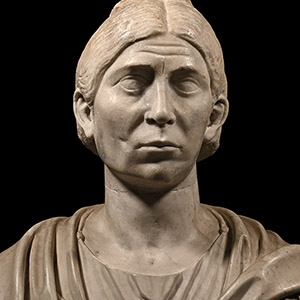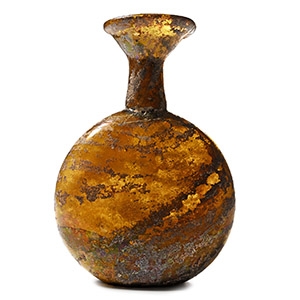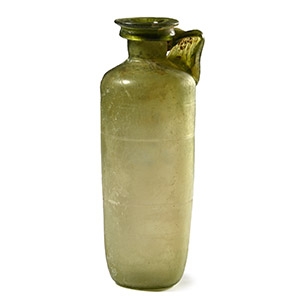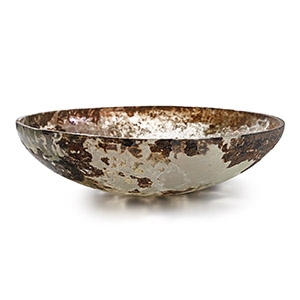Home > Auctions > 3 - 11 June 2025
Ancient Art, Antiquities, Books, Natural History & Coins
Acquired by Albert Sfez in the early 1950s.
Formerly the property of Monsieur Alain Sfez, a Belgium collector; acquired by gift from his father Albert Sfez, in 1965.
Acquired by a London dealer in 1973.
From an important London collection since 1975; thence by descent.
Accompanied by a copy of a four page illustrated academic report by Professor Dr. phil. Peter Rothenhöfer.
This lot has been checked against the Interpol Database of stolen works of art and is accompanied by a search certificate number no.12672-230807.
This lot has been cleared against the Art Loss Register database, and is accompanied by an illustrated lot declaration signed by the Head of the Antiquities Department, Dr Raffaele D'Amato.
For testaments and further documents from the same collection see Rothenhöfer, Peter, and Blänsdorf, Jürgen Sana mente sanaque memoria testamentum feci: Eine testamentarische Verfügung vom 12. April 340 n. Chr., Gephyra 13 (2016), pp.153-163; Rothenhoefer, P. Bemerkungen zum Testament des Pomponius Maximus aus dem Jahr 371 n. Chr. (Notes on the Testament of Pomponius Maximus from the Year AD 371). Zeitschrift der Savigny Stiftung für Rechtsgeschichte (Romanistische Abteilung), 142, 2025, pp.200-232; Rothenhöfer, P., Neue römische Rechtsdokumente aus dem Byzacena-Archiv / New Roman Legal Documents from the Byzacena Archive, (forthcoming); and cf. Rothenhöfer, Peter and Wang, Weixia Flavius Aelius Victorinus praeses provinciae Numidiae, VDI 2025 (forthcoming); Wang, Weixia, Vibius Flavianus, First Governor of the provincia Valeria Byzacena, VDI 2025 (forthcoming).
Exhibited at the Harwich Museum, Harwich, Essex, UK, 12th March-9th June 2025; accompanied by a copy of a photograph of the artefacts on display.
Private collection of the gentleman, J.L. Fernández, Switzerland, before 2000.
From the private academic collection of Professor P.M.A.R.
Accompanied by a copy of the academic paper Rothenhoefer, P., Römische Offiziere auf einer tabella defixionum. Ein außergewöhnliches Dokument magischen Schadenzaubers gegen eine Legionskommandeur und weitere Mitglieder des Offizierskorps, Epigraphica 78, 2016, pp.235-251, where this unique curse tablet is published.
This lot is accompanied by an illustrated lot declaration signed by the Head of the Antiquities Department, Dr Raffaele D'Amato.
Rothenhoefer, P., Römische Offiziere auf einer tabella defixionum. Ein außergewöhnliches Dokument magischen Schadenzaubers gegen eine Legionskommandeur und weitere Mitglieder des Offizierskorps, Epigraphica 78, 2016, pp.235-251; Sánchez Natalías, C., Sylloge of Defixiones from the Roman West. A Comprehensive Collection of Curse Tablets from the Fourth Century BCE to the Fifth Century CE, Oxford, 2022, no.149.
with Georges Joseph Demotte (1877-1923) and Andrée Macé (1918-2000), Belgium and New York.
Collection Demotte/Andrée Macé; Jean-Claude Renard Auction, Suresnes, 3 September 2013, no.87.
with Galerie Chenel, Paris, 2021.
This lot has been checked against the Interpol Database of stolen works of art and is accompanied by a search certificate number no.12624-236336.
This lot has been cleared against the Art Loss Register database, and is accompanied by an illustrated lot declaration signed by the Head of the Antiquities Department, Dr Raffaele D'Amato.
For similar frieze visible on the tomb of Caecilia Metella in Rome see Napp, A.E., ‘Bukranion und Guirlande. Beiträge zur Entwicklungsgeschichte der hellenistischen und römischen Dekorationskunst,' Heidelberg University, 1933, p. 2.
In classical Rome bovine skulls decorated the friezes of entablatures. Often, they were positioned in the metopes of Doric entablatures, but also in Ionic and Corinthian friezes, sometimes connected by floral or drapery swags. The architectural term for these skulls is bucranium (pl. bucrania or bucranes), a word derived from the Latin bos, meaning ox or cow, and cranium, the Medieval Latin term for a skull. The skulls allude to the ancient Greek and Roman ceremonies of sacrifice.
Acquired in the mid 1980s-1990s.
Private collection, Switzerland, thence by descent.
Private collection, since the late 1990s.
Accompanied by an academic report by Dr Raffaele D’Amato.
This lot has been checked against the Interpol Database of stolen works of art and is accompanied by search certificate number no.12578-232182.
This lot has been cleared against the Art Loss Register database, and is accompanied by an illustrated lot declaration signed by the Head of the Antiquities Department, Dr Raffaele D'Amato.
Cf. Racinet, A., Le Costume Historique, 6 vols, Paris, 1883; Hottenroth, F., Il Costume, Le Armi, Gli Utensili dei Popoli Antichi e Moderni, Vols I–II, Rome, 1887–92; Vermeule, C.C., Hellenistic and Roman Cuirassed Statues, Berytus XIII, Copenhagen, 1959; D’Amato, R., Sumner, G.,Arms and Armour of the Imperial Roman Soldier, from Marius to Commodus, 112BC-AD 192, London, 2009, fig.312; D’Amato, R., Roman Army Units in the Eastern Provinces (2), Oxford, 2022, p.17, relief of a soldier with dog from Tirana.
The military boot cothurnus worn here by a hunter or a military commander, was widely used by commanders of the Roman army, and sometimes by actors playing military heroes. Officers wore splendid closed cothurni of various colours, like those realised in blue leather and worn by an officer represented on a fresco from Stabiae (D’Amato-Sumner, 2009, p.13).
Pierre Sciclounoff collection, acquired in 1970.
Byron Zoumboulakis collection, acquired in 1986.
Accompanied by a copy of an Art Loss Register certificate, dated 11 August 2004.
This lot has been checked against the Interpol Database of stolen works of art and is accompanied by a search certificate number no.12673-234639.
This lot has been cleared against the Art Loss Register database, and is accompanied by an illustrated lot declaration signed by the Head of the Antiquities Department, Dr Raffaele D'Amato.
Pierre Sciclounoff was a noted 20th century collector with a particular interest in classical and Near Eastern antiquities. His collection was widely regarded for its scholarly depth and was formed during a period of active collecting in Europe during the post-war decades. Byron Zoumboulakis, a prominent Greek collector and art dealer, is known for his extensive contributions to the art world through the Zoumboulakis Galleries in Athens, established by his family. His collection spans antiquities, modern, and contemporary art, and he has played a key role in promoting cultural heritage in Greece.
French private collection, 18th century.
with Mercier & Cie, Lille, France, 6 October 2019, no.199.
Private collection, Europe.
Accompanied by a copy of French passport no.217723, dated 27 February 2020.
This lot has been checked against the Interpol Database of stolen works of art and is accompanied by a search certificate number no.12674-236274.
This lot has been cleared against the Art Loss Register database, and is accompanied by an illustrated lot declaration signed by the Head of the Antiquities Department, Dr Raffaele D'Amato.
The present work exhibits a distinctive coiffure that gained prominence among aristocratic Roman women during the mid-3rd century A.D., most notably under the empresses Furia Sabinia Tranquillina, consort of Gordian III, and Otacilia Severa, wife of Philippus Arabs. This elaborate arrangement - central parting, voluminous curls, and a braided crown - is a key chronological indicator, allowing the portrait to be securely dated to this period. The head is mounted on an 18th century bust inscribed 'IVLIA MAESA'. While this identification reflects an earlier attribution, current stylistic analysis suggests a slightly later date, aligning the portrait more plausibly with the generation following Julia Maesa’s death in A.D. 224/225.
Private collection, Europe.
Acquired on the European art market, 2002.
Private Swiss collection.
Accompanied by an academic report by Dr Raffaele D’Amato.
This lot has been checked against the Interpol Database of stolen works of art and is accompanied by a search certificate number no.12574-232106.
This lot has been cleared against the Art Loss Register database, and is accompanied by an illustrated lot declaration signed by the Head of the Antiquities Department, Dr Raffaele D'Amato.
Cf. Bianchi Bandinelli, R., Roma, la fine dell'arte antica, Milano, 1970, fig.76; Frel, J., Roman Portraits in the Getty Museum,Malibu, 1981, fig.93; Cf. Donati, A., Gentili, G., Costantino Il Grande, la civilta' Antica al bivio fra Occidente ed Oriente, Milano, 2005, pp.204ff.; cf. also Biscottini, P., Sena Chiesa, G., Costantino, 313 d.C., l’Editto di Milano e il tempo della tolleranza, Milano, 2012, pp.124, 179, 182, 185, 187.
The portrait, for style and artistic structure, can be compared with the ones of Diocletian and his colleague Maximianus Herculius, and with most of the emperors of the so-called Tetrarchic Period. Like in the portrait of Diocletian and Maximianus, this military man is portrayed with bags under his eyes and with a harsh facial expression. The wrinkles on his forehead and around his mouth show the feelings of a man engaged in difficult times. Stylistically the face presents affinity with the portrait of Diocletian or Maximianus Herculius at the Uffizi (inv.242), some elements also recall the portrait of Decius at the Musei Capitolini (inv.482). We can therefore date the artwork in the period between the second half of the 3rd century and the first decade of the 4th century A.D.
Ex London gallery, UK, 1986.
Ex private UK collection.
This lot is accompanied by an illustrated lot declaration signed by the Head of the Antiquities Department, Dr Raffaele D'Amato.
From an important London collection of glass, 1990s.
This lot is accompanied by an illustrated lot declaration signed by the Head of the Antiquities Department, Dr Raffaele D'Amato.
Cf. Lightfoot, C.S., Ancient Glass in National Museums Scotland, Edinburgh, 2007, item 270, for type.
From a private Scottish collection pre 1980, by descent.
This lot is accompanied by an illustrated lot declaration signed by the Head of the Antiquities Department, Dr Raffaele D'Amato.
Acquired in the mid 1980s-1990s.
Private collection, Switzerland, thence by descent.
Private collection, since the late 1990s.
Accompanied by an academic report by Dr Raffaele D’Amato.
This lot has been checked against the Interpol Database of stolen works of art and is accompanied by a search certificate number no.12613-234626.
This lot has been cleared against the Art Loss Register database, and is accompanied by an illustrated lot declaration signed by the Head of the Antiquities Department, Dr Raffaele D'Amato.
Cf. Harden, D.B., Glass of the Caesars, Milan, 1987, no.17, for similar.
Small bottles, lidded pyxides (boxes) of this type and luxury gold-band glass were made during the Julio-Claudian period. The production and widespread use of tableware in marbled glass in the Western empire took place between the end of the age of Augustus and the beginning of the age of Tiberius (circa 10-16 A.D.), reaching its peak in the period of Nero (54-68 A.D.).
From an important London collection of glass, 1990s.
This lot is accompanied by an illustrated lot declaration signed by the Head of the Antiquities Department, Dr Raffaele D'Amato.
Cf. The Metropolitan Museum, accession number 81.10.32, for a later comparable example.
61 - 72 of 3130 LOTS


.jpg)
.jpg)
.jpg)











